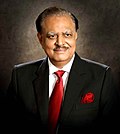Top Qs
Timeline
Chat
Perspective
Governor of Sindh
Appointed head of the province of Sindh, Pakistan From Wikipedia, the free encyclopedia
Remove ads
The governor of Sindh is the appointed head of the province of Sindh, Pakistan. The office of the governor as the head of the province is largely a ceremonial position; the executive powers lie with the Chief Secretary and the Chief Minister of Sindh.
However, there were instances throughout the history of Pakistan, the powers of the provincial governors were vastly increased, when the provincial assemblies were dissolved and the administrative role came under direct control of the governors, as in the cases of martial laws of 1958–1972 and 1977–1985, and governor rules of 1999–2002. In the case of Sindh, there were three direct instances of governor's rule under Mian Aminuddin, Rahimuddin Khan and Moinuddin Haider respectively, in 1951–1953, 1988, and 1998 when the provincial chief ministers of those times were removed and assemblies dissolved.
The governor is appointed by the president on the advice of the prime minister. The Governor House in Karachi is the official residence of the governor of Sindh. Kamran Tessori is the current governor of Sindh.
Remove ads
Caliphate
The Muslim province of Sind was under the reign of Umayyad and Abbasid caliphates. The governor of Sind was an official of Umayyad and Abbasid caliphates.[1]
Mughal Empire
Following its annexation of Sindh's independent sultanates, the Mughal Empire administered southern Sindh as the Thatta Subah or Sarkar from 28 Mar. 1593 until the early 18th century. Northern Sindh was ruled separately by the Kalhora dynasty until around 1739, when Persian assistance allowed them to annex Thatta Subah as well. Following the 1783 Battle of Halani, Kalhora control was replaced by the Talpur dynasty.[citation needed]
Remove ads
British Raj
Sir Charles Napier (1843-1847) became the first ever Chief Commissioner and Governor of Sind.[2]
Pakistan
Summarize
Perspective
Following is the list of Sindh governors after the independence of Pakistan in 1947.
Remove ads
See also
- Chief Minister of Sindh
- Government of Sindh
- Provincial Assembly of Sindh
- List of governors of Pakistan
- List of chief ministers in Pakistan
- List of presidents of Pakistan
- List of commissioners and governors of Sind in British India
- Commissioner Karachi
- Mayor of Karachi
- Administrator Karachi
- Government of Karachi
Notes
- A number in parentheses indicates that the incumbent has previously held office.
References
External links
Wikiwand - on
Seamless Wikipedia browsing. On steroids.
Remove ads










